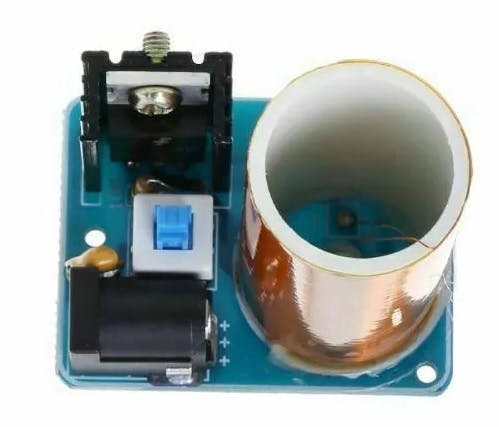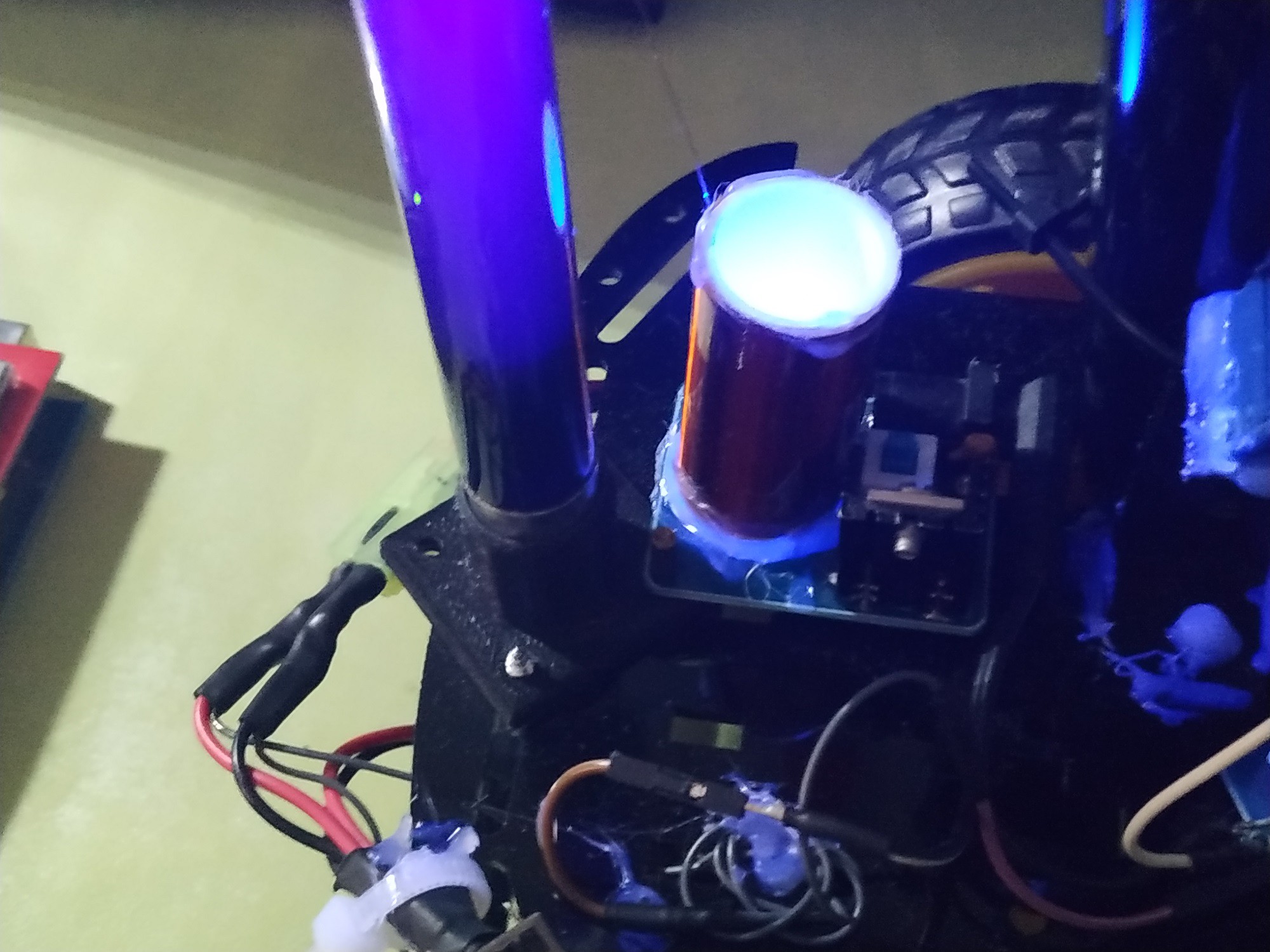Tesla Coil
A Tesla coil is an electrical resonant transformer circuit designed by inventor Nikola Tesla in 1891. It is used to produce high-voltage, low-current, high frequency alternating-current electricity. Tesla experimented with a number of different configurations consisting of two, or sometimes three, coupled resonant electric circuits. Tesla used these circuits to conduct innovative experiments in electrical lighting, phosphorescence, X-ray generation, high frequency alternating current phenomena, electrotherapy, and the transmission of electrical energy without wires. Reference: https://en.wikipedia.org/wiki/Tesla_coil

Tesla coil close-up
In this project I'm using this principle to transmit electrical energy to the UV lamp by means of a Tesla mini coil. Thanks to this great invention I have the following advantages:
- I have saved money on the purchase of a ballast, and an AC converter;
- The robot is less heavy and less big;
- I'm not using UV LEDs, which have very low power, and I'm not simulating UV radiation. This is real.
Where can I get this device? Example: https://www.elecrow.com/mini-diy-tesla-coil-kit.html

Mini DIY Tesla Coil
UV Lamp
I'm using a UV lamp. UV light helps detect the records and watermarks that are included in bills and important documents. This lamp has a power of 6 watts and a life time of approximately 8000 hours.

UV lamp
Assembling Tesla coil and UV lamp, recommendations:
- Mount the Tesla coil and UV lamp on the back of the autonomous robot.
- My UV lamp was turned on at a maximum distance of 2 cm from the Tesla coil, so I set them at a distance of 1 cm to ensure the lighting of the UV lamp. You can try something similar.

UV Meter
The World Health Organization publishes a practical guide on the UV index in which it explains the health risks of ultraviolet radiation and proposes some protective measures depending on their intensity.

UV index
This is optional; to measure UV radiation I've developed this device, and using the UVM30A sensor. I show you the electrical diagram in the figure below:

UV Meter
Code: uv-meter.ino
//AUTHOR: GUILLERMO PEREZ GUILLEN
#include <MCUFRIEND_kbvw.h>
#include <TouchScreen.h>
int16_t BOXSIZE;
uint16_t ID, currentcolor;
uint8_t Orientation = 0; //PORTRAIT
String UVIndex = "0";
String Index = " ";
// Assign human-readable names to some common 16-bit color values:
#define BLACK 0x0000
#define CYAN 0x07FF
#define MAGENTA 0xF81F
#define YELLOW 0xFFE0
#define WHITE 0xFFFF
void setup()
{
while (!Serial);
Serial.begin(57600);
uint16_t tmp;
tft.reset();
ID = tft.readID();
tft.begin(ID);
tft.setRotation(Orientation);
tft.fillScreen(BLACK);
}
void loop()
{
float sensorVoltage;
float sensorValue;
sensorVoltage = (sensorValue * (5.0 / 1023.0))*1000; //Voltage in miliVolts
////////////////////////// UV Index
if(sensorVoltage<50.0)
{
UVIndex = "0";
Index = "LOW";
}
else if (sensorVoltage>=50.0 && sensorVoltage<227.0)
{
UVIndex = "0";
Index = "LOW";
}
else if (sensorVoltage>=227 && sensorVoltage<318)
{
UVIndex = "1";
Index = "LOW";
}
else if (sensorVoltage>=318 && sensorVoltage<408)
{
UVIndex = "2";
Index = "LOW";
}else if (sensorVoltage>=408 && sensorVoltage<503)
{
UVIndex = "3";
Index = "MEDIUM";
}
else if (sensorVoltage>=503 && sensorVoltage<606)
{
UVIndex = "4";
Index = "MEDIUM";
}else if (sensorVoltage>=606 && sensorVoltage<696)
{
UVIndex = "5";
Index = "MEDIUM";
}else if (sensorVoltage>=881 && sensorVoltage<976)
{
UVIndex = "8";
Index = "VERY HIGH";
}
else if (sensorVoltage>=976 && sensorVoltage<1079)
{
UVIndex = "9";
Index = "VERY HIGH";
}
else if (sensorVoltage>=1079 && sensorVoltage<1170)
{
UVIndex = "10";
Index = "VERY HIGH";
}
else if (sensorVoltage>=1170)
{
UVIndex = "11";
Index = "THE HIGHEST"; // EXTREMELY HIGHEST
}
/////////////////////////////////////
Serial.print("sensor reading = ");
Serial.print(sensorValue);
Serial.println("");
Serial.print("sensor voltage = ");
Serial.print(sensorVoltage);
Serial.println(" V");
Serial.print("UV Index = ");
Serial.print(UVIndex);
tft.setCursor(0, 5);
tft.setTextSize(3);
tft.setTextColor(MAGENTA, BLACK);
tft.println(" UV METER");
tft.println(" ");
tft.setTextColor(YELLOW, BLACK);
tft.println("mV: " + String(sensorVoltage) + " ");
tft.println(" ");
tft.println("UVIndex: " + String(UVIndex) + " ");
tft.setTextColor(WHITE, BLACK);
tft.println(" ");
tft.println(String(Index) + " ");
delay(1000);
}
 Guillermo Perez Guillen
Guillermo Perez Guillen
Discussions
Become a Hackaday.io Member
Create an account to leave a comment. Already have an account? Log In.